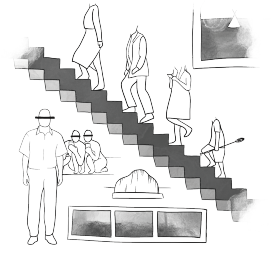IF YOU HAVE NOT VIEWED THE FILM PARASITE, PLEASE DO NOT READ THIS ARTICLE AS IT DOES CONTAIN SPOILERS!

Sweeping the Oscars with a total of 4 awards (including Best Film), Parasite has become one of the most popular names in the theatre industry. Bong Joon Ho, regarded as one of the best directors of this decade, created this masterpiece to center around the class difference between the Kim and Park families.
The Park family lives in an extravagant home, with well-watered gardens and an entire team to keep the house neat and tidy. The Kims live partially beneath the ground, keeping their windows open for free insecticide from the street.
Due to the large contrast in social class, the Kims hold resentment towards the Parks. They gradually assimilate into the Park household by becoming tutors, drivers, and caretakers. A necessary aspect of their assimilation plan is to keep their familial bonds outside of the Park’s home. Bong Joon Ho, in order to display the contrast between these two families, uses three motifs: the stairs, a window, and a rock.
The stairs represent the class change that occurs throughout the film. The Park’s extravagant house, built specifically for the film, centers around a grand staircase. At the beginning of the film, we consistently see members of the Park family leading members of the Kim family up the stairs, symbolizing the movement of social class.
But Bong Joon Ho places another stairwell behind the shelves of the Parks’ home. In the second half of the film, the Kims’ struggles shift from the class hierarchy they face with the Parks towards trying to keep their familial relationship hidden. In an unplanned event, Moon-Gwang, the housekeeper who was forced out of the house by the Kims, returns to the Kim family sharing a feast in the Parks’ home when the Parks leave on a camping trip.
Moon-Gwang threatens to send the Parks a photo of their feast if they do not allow her to enter the house and collect what she left in the basement. She enters the basement, where her husband, on the run from shark loans, has been living for many years, unknown to the Parks.
The story shifts here, quickly becoming a fight for power. As Moon-Gwang and her husband fight the Kims to prevent them from revealing this secret to the Parks, each character shows a power change while running up and down the basement stairs. When at the bottom of the staircase and in the basement, the characters display a loss of power as they remain hidden and without a voice, but those at the top of the staircase are free to reveal secrets to the Parks. In the film Parasite, two major staircases come into play, one representing the social hierarchy of Korea and the other representing a contrast in power.
Bong Joon Ho also places the window within the film Parasite as another motif. The film begins with the window which looks into the Kims’ house. It is a decrepit window that faces the street outside, where a drunk man continuously pees into their home. They have no privacy within their home and face many negative impacts from the outside world.
But, when staying at the Parks’ home, the Kims experience a large window that faces onto a well-watered garden. Rather than the coach’s arrangement being seated in front of a television, it instead faces the outside world, representing how to them, everything outside of their homely bubble appears to be entertainment. Large bushes and trees provide the Kims with a new sense of privacy. The privacy that the Parks live with is just one example of the privileges that are given to the wealthy elite. The two windows display the different lives the two families live and the simple right to privacy that is only offered to the rich.
The rock, otherwise known as a suseok, is given to Ki Woo, the Kims’ son, by his close friend Min. Min gives Ki Woo the rock in hopes that it will bring wealth and stability to the Kim family.
During the first half of the film, the Kims are running a successful scheme, making thousands of won off of the Park family. During the later end of the film, the Kims face a flood that leaves their house in ruins. But rather than reaching for money or passports, the Kims grab the rock and leave their home behind holding nothing but this object. They have a strong tie to the rock as it represents the stability within their lives, and they believe in the superstition that the rock has brought them their newfound success.
But this success begins to fade when the power struggle between the Kims and Moon-Gwan comes into play. The Kims slowly lose grip over the stability they once had, and the film begins to turn into a chaotic sequence of unplanned events.
This lack of stability comes to fruition when Moon-Gwan’s husband hits Ki Woo over the head with the rock. The narrative completely loses direction and turns into complete chaos. The crashing of the rock in this last scene where some resemblance of stability remains for the Kim family.
In my mind, Parasite is a well thought out and planned film where every action, angle, and image is carefully crafted. When watching the film for a second and third time, I’m able to notice new and interesting aspects emerge. Bong Joon Ho was able to masterfully construct a film that displays the class divide in Korea through three very subtle motifs. The three motifs are all small but still able to represent a larger mosaic. Moving elegantly around one another, each motif comes together in the end like a play or a dance. We should applaud and celebrate Bong Joon Ho on this masterpiece he was able to create!

